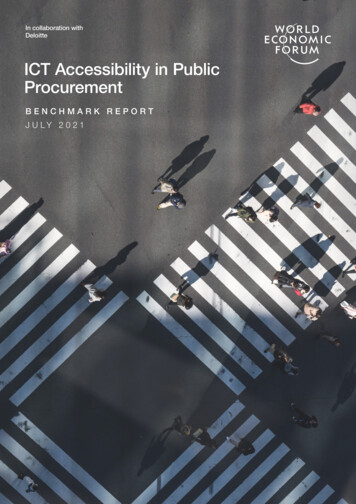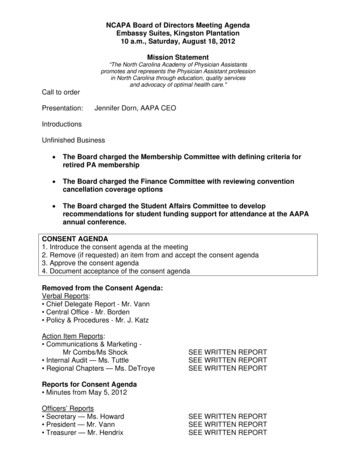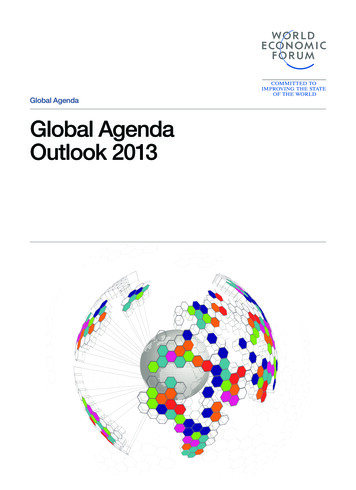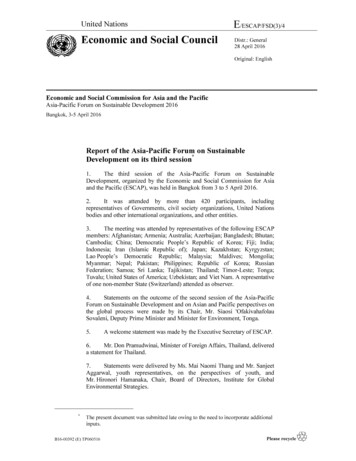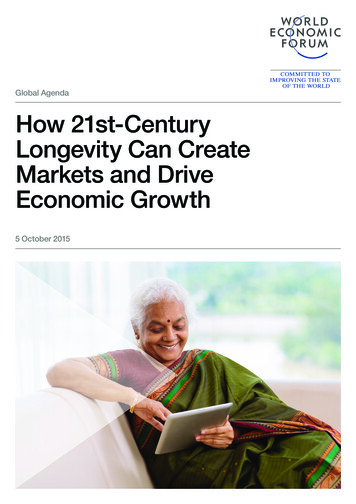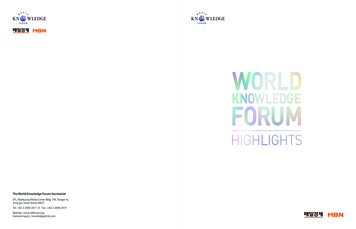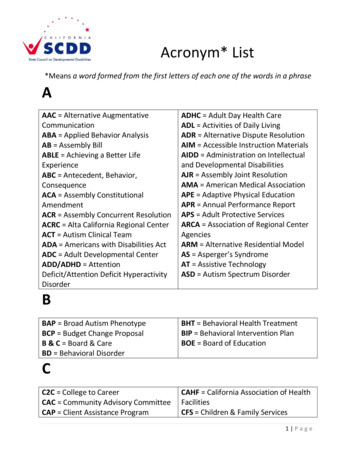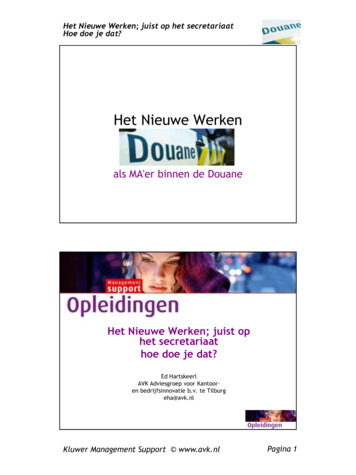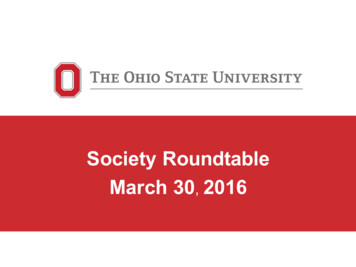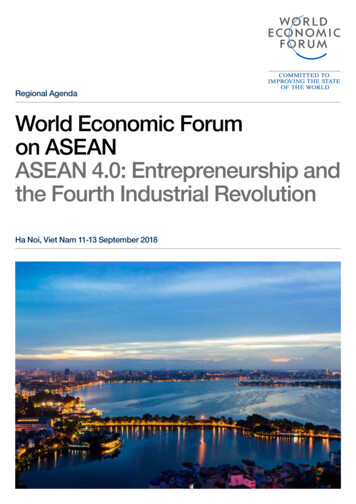
Transcription
Regional AgendaWorld Economic Forumon ASEANASEAN 4.0: Entrepreneurship andthe Fourth Industrial RevolutionHa Noi, Viet Nam 11-13 September 2018
Contents04Preface06Meetinghighlights0607Shaping the agendaThe view from the top08Read what leaders said aboutthe issuesProject progress14Results, announcements, andupdates from the meeting onprojects being run in ASEANon the World Economic ForumplatformCultural connectionASEAN's next generationcompanies share stories oftransformation and disruption2World Economic Forum on ASEANCan ASEAN turngeostrategic andtechnological disruptioninto opportunity?Asian leaders call forrules-based geopolitics322224Asian countries must defendthe global system of rulesbased multilateralismTalking ‘bout mygeneration20Mekong leaders reaffirmcommitment to joinforces29Time to reconnect to humanvalues, say experts25ASEAN is a young region withold politicians .Art, music, and literature playan important role in enrichingthe discussions at the meetingEighty South-East Asianstart-ups feature in themeetingRethinking the city28Diversity is the region'sstrengthBørge Brende and JustinWood perspectivesSee the statisticsMeeting Co-ChairsHow can the region respond tofluid geo-economics, shiftingtrade relationships and newpower dynamics to securepeace and prosperity for all?RegionalgovernanceA note from Justin Wood onthis year’s record-breakingmeetingThe meeting in numbers22Is pluralism underthreat?Economicand businessdynamismUnderstand the drivers of newbusiness models, the shape ofemerging economic systemsand the requirements for agilegovernanceGrow Asia: Embracingtechnology to transformfood systems32Meeting global demand forsustainable foodMissed opportunity:Diaspora networks26Harnessing the economicpower of overseas citizens27ASEAN youth bullishabout impact oftechnology on jobs33Integration is a pressing priorityTurning the tide onplasticHow to tackle this crisis21Optimism abounds onemployment prospects34
Don’t do normal stuff,don’t ask for money: Atech CEO's surprisingadvice4436Positive outlook despitelooming threatsE-commerce needssupport to empowerSMEsPublic joins Open Forumdiscussion on ASEAN4.0Optimism about ASEANeconomic outlook3738ASEAN e-market's enormouspotentialFactory Asia's nextfrontier40New study on reducing theworldwide trade finance gap4445Tackling the toxic normsthat hold women backin Asia41Funding the endgameagainst malaria4641Collaboration between thepopulation, the governmentand the private sector is key58Acknowledgements60Digital updateThe event page of the World EconomicForum on ASEAN50An end to the scourge?Preparing for jobs of thefuture55Find out which companies providedvaluable support for the meetingAnne-Birgitte Albrectsenoutlines what needs to changeA mixed picture across theregionDistributed-ledgertechnologies couldenable 1 trillion in tradeASEAN-led healthcaresystemsPersistent social inequalitiestake the lustre off growthTracking illicit money flows withtechExpanding financialinclusionNew approaches toreducing inequality54In Asia-Pacific, one persondies in a traffic accident every40 secondsNam features start-upsTime to accelerate regionalintegration of productionsystemsDigital tools and the illiciteconomySteering ASEANtowards safer roadsFirst ever Open Forum in Viet3953How will we work in years tocome?Social inclusionExplore how to shapethe forces of change todrive access to betterhealthcare and education,new infrastructure, financialinclusion and moreaccountable governance.Look for the magicWorkplace 4.05161ContributorsWhat's ahead in the world ofwork?Tackling malnutritionthrough tech52Teaming up to educate peopleabout proper nutritionWorld Economic Forum on ASEAN3
PrefaceWorld Economic Forumon ASEANASEAN 4.0: Entrepreneurshipand the Fourth IndustrialRevolutionJustin WoodHead of Asia-Pacific and Member of the ExecutiveCommittee, World Economic ForumWorld Economic Forum 2018, All rights reserved.No part of this publicationmay be reproduced ortransmitted in any form orby any means, includingphotocopying andrecording, or by anyinformation storage andretrieval system.REF 1510184World Economic Forum on ASEAN
This year’s World EconomicForum on ASEAN was the secondtime that we have staged ourregional meeting in Viet Nam. Thefirst was in 2010, in Ho Chi MinhCity.During those eight interveningyears, the economic story inViet Nam has been particularlyimpressive. The country’s GDPhas nearly doubled in US terms,while the value of exports hasnearly tripled. But this story isnot unique to Viet Nam. Strongand robust economic growthhas been evident right acrossthe 10 countries of ASEAN, andcontinues at around 5% a year inreal terms.Today, however, we face the ageof the Fourth Industrial Revolution.New technologies such asartificial intelligence, advancedrobotics, blockchain, autonomousvehicles, the internet of thingsand many others are collectivelycausing massive transformationsaround the world.Technological change is deliveringexciting solutions to persistentproblems, and empoweringnew business models and newforms of social and economicinclusion, especially for lowerincome countries. But it is alsothrowing up important questionsthat business, government andpolicy-makers must address. InASEAN, these transformationshave the potential to generate ahighly positive future. But equally,they could cause the strong storycurrently unfolding to weaken.Consider the future of jobs.In ASEAN, the labour force isforecast to expand by 11,000workers every day for the next 15years. And yet, industrial robotsnow out-compete low-skilledmanufacturing labour. Artificialintelligence threatens ASEAN’sservice jobs. Self-driving vehiclesare already at work in SouthEast Asia. How will the region’sgrowing workforce find jobs?Addressing these issues will callfor entrepreneurship. At onelevel, the region must unleash theentrepreneurial spirit of individualsand small and medium-sizedenterprises (SMEs) to build newcompanies and new industries.But just as important, ASEANmust embrace entrepreneurship inthe crafting of policy, governancemodels, geopolitical relationshipsand new approaches to inclusivegrowth. In short, there must beentrepreneurship not only in thebusiness interest, but in the publicinterest too.Some 1,000 participants from45 countries gathered to debatethese issues, and many others.And, for the first time, the meetingfeatured 80 of the region’s mostexciting and dynamic start-upsto help enrich the understandingof what the future will look like.The discussions and workshopswere both frank and constructive,generating a wealth of ideas forthe future.The World Economic Forum isgrateful to all who joined themeeting for their commitment anddynamic participation. We lookforward to welcoming you to nextyear’s gathering.This was the key question on theagenda at our meeting in Ha Noi:How to steer the transformationsof the Fourth Industrial Revolutionin a positive direction for theregion?World Economic Forum on ASEAN5
Meeting highlightsThe meeting innumbersMore than 1,000 participantsfrom 45 countries80 of the region’s mostMore than 90 public figures,representing all 10 ASEANnations, including 8 heads ofstate/governmentMore than 70 young leaders,including Global Shapers,Social Entrepreneurs andYoung Global LeadersOver 650 businessparticipantsMore than 50 participants areleaders in media, civil societyand academiaFor session highlights, blogs, videos andmeeting-related documents, plus Forum insights,visit https://toplink.weforum.org/6World Economic Forum on ASEANdynamic start-ups
Meeting Co-ChairsAs education has becomemore and more inclusive theeconomies are still not taking fulladvantage of that really fantasticresource: well-educated youngwomen in their workforce.ASEAN does recognize the 4.0challenge and I am optimisticabout what the ASEAN secretariatwill do now going forward.Nazir Razak, Chairman, CIMB Group Holdings,MalaysiaAnne-Birgitte Albrectsen, Chief ExecutiveOfficer, Plan International, United KingdomOn US-China relations, if you lookat just the trade side it does looktense, but I think these are twobig players on the global stagewith strategic calculations thatsometimes diverge, but also attimes converge. And I think on theNorth Korea nuclear issue, theyhave converged.Kang Kyung-Wha, Minister of Foreign Affairs ofthe Republic of KoreaFor all the talk of trade conflict the underlying fundamentals ofthis part of the world remain solid.And therefore while there may beturbulence in the near term, weshould expect and can believe ina very positive future for ASEANand beyond.We can still be making moreprogress [towards integration] butbe extremely mindful about theconsequence for those who are left behind.Sri Mulyani Indrawati, Minister of Finance ofIndonesiaWe have to train people sothey are adept at change, notonly technological training, butsoft skills too. I think the FourthIndustrial Revolution is more abouta mindset revolution.Nguyen Manh Hung, Acting Minister ofInformation and Communications of Viet NamKevin Sneader, Global Managing Partner,McKinsey & Company, Hong Kong SAR, ChinaWorld Economic Forum on ASEAN7
The view from the topIn the Opening Plenary of the World Economic Forum on ASEAN, leaders gave impassionedspeeches on some of the priorities they see for the region in the era of the Fourth IndustrialRevolutionOn tradeWe are moving from a unipolar to amultipolar world, and from a uniconceptualto a multiconceptual world. This is leadingto increased fragility of our global system,while also enhancing the potential for globalconflicts, as we see now with the potentialof trade wars. Despite our differences, weshould never forget that we have commonglobal interests and a common globalresponsibility. Just think of preservingour natural resources. The ASEAN wayof striving for consensus among diversecountries can serve, particularly duringdifficult times, as a good role model for ourworld.Klaus Schwab, Founder and Executive Chairman, WorldEconomic ForumIn the world economy today, we are headingtowards ‘Infinity Wars’. Not since the GreatDepression of the 1930s have trade warserupted with the intensity of today. But, restassured, I and my fellow Avengers stand readyto prevent Thanos We must prevent thetrade wars from becoming the ‘Infinity Wars’.You might be wondering who is Thanos?Thanos is not any individual person. Thanos isinside all of us. Thanos is the misguided beliefthat, in order for us to succeed, others mustsurrender.Joko Widodo, President of Indonesia8World Economic Forum on ASEANThe world economy is picking up, butuncertainties and destabilizing factors areon the rise, particularly as some countries’protectionist and unilateral measuresare gravely undermining the rules-basedmultilateral trading regime, posing asignificant hazard to the world economy We must uphold openness and mutualbenefits. We can learn from history thatself-isolation will lead nowhere and onlyopenness for all represents the right wayforward.Hu Chunhua, Vice-Premier of the People's Republic ofChina
Borge Brende, President, World Economic Forum; Daw Aung San Suu Kyi, State Counsellor of Myanmar; Lee Hsien Loong, Prime Minister of Singapore; Samdech Techo HunSen, Prime Minister of the Kingdom of Cambodia; Joko Widodo, President of Indonesia; Nguyen Phu Trong, General Secretary of the Communist Party of Viet Nam; NguyenXuan Phuc, Prime Minister of Viet Nam; Klaus Schwab, Founder and Executive Chairman, World Economic Forum; Thongloun Sisoulith, Prime Minister of the Lao People’sDemocratic Republic; Hu Chunhua, Vice-Premier of the People’s Republic of China; Ranil Wickremesinghe, Prime Minister of Sri Lanka; and Prajin Juntong, Deputy PrimeMinister and Minister of Justice of ThailandOn the Fourth Industrial RevolutionI believe this that this Fourth IndustrialRevolution will create more jobs than itdestroys, not only in the long-term buteven in the short-term I believe that theFourth Industrial Revolution will not increaseinequality, but will reduce it, because we seedramatic cost reductions for many productsand services, which will make them cheaperand more accessible to lower-incomepeople As our economies develop theyare being driven increasingly not by naturalresources that are limited, but by humantalent, which is unlimited.Joko Widodo, President of IndonesiaThe Fourth Industrial Revolution will changebusiness models, economies and societiesin fundamental and disruptive ways. Globalcompetition will be determined by innovativecapabilities and capacities, and less by costfactors the countries that succeed inthe era of the Fourth Industrial Revolutionwill be characterized by innovative andentrepreneurial ecosystems [We must]provide the necessary conditions for startups and SMEs to thrive and flourish andprovide the necessary jobs.Klaus Schwab, Founder and Executive Chairman, WorldEconomic Forum[As well as opportunities] the FourthIndustrial Revolution will also causeanxiety the need for higher education andskills the unequal access to knowledgeand the unequal distribution of benefits the potential for IT-related crimes thatcould affect national and regional security. the lack of proper regulations for thegovernance of data and privacy.When we think of ASEAN, many think ofdiverse and abundant natural resourcesto be harnessed, as well as the factory ofthe world. But with the Fourth IndustrialRevolution advanced technologies andthe digital economy are the new areas ofbig potential The opportunities broughtabout by the Fourth Industrial Revolution forASEAN are indeed enormous.Samdech Techo Hun Sen, Prime Minister of the Kingdomof CambodiaNguyen Xuan Phuc, Prime Minister of Viet NamWorld Economic Forum on ASEAN9
On ASEAN economic integrationASEAN is committed to further economicintegration. This is an important condition forthe Fourth Industrial Revolution because it’sabout building new networks, creating newsynergies, and staying connected TheFourth Industrial Revolution is a dynamicand continuing process. We can’t predictexactly how it will unfold, but I am optimisticabout our future, because ASEAN has itsown competitive strengths. And, by poolingour ideas and resources and integrating oureconomies, we will be in a strong position toride on this fourth wave.ASEAN must respond to the FourthIndustrial Revolution as a region Datais the foundation of the Fourth IndustrialRevolution. We need to establish the groundrules for an ASEAN code on data-sharingcooperation to standardize the effective useand sharing of data [In addition] Viet Namwants to propose cross-ASEAN single ratemobile coverage.Nguyen Xuan Phuc, Prime Minister of Viet NamLee Hsien Loong, Prime Minister of SingaporeFor Thailand, the Fourth Industrial Revolution represents a big turning point in how we live anddo business At the national level, the Royal Thai government came up with the Thailand4.0 policy But, the government also recognizes that digital technology connects all ofus together. Thailand cannot go forward alone As chair of ACMECS this year, we placeemphasis on the linking of the five Mekong countries together to create a seamless regionalvalue chain and lead our region forward into the era of the Fourth Industrial Revolution.Prajin Juntong, Deputy Prime Minister and Minister of Justice of ThailandLee Hsien Loong, PrimeMinister of Singapore10World Economic Forum on ASEANPrajin Juntong, DeputyPrime Minister andMinister of Justice ofThailandNguyen Xuan Phuc,Prime Minister of VietNam
On ASEAN’s demographic dividendOne of the most important aspects of theFourth Industrial Revolution is the humanfactor We have to teach our peoplenew skills and give them the confidence totake the new learning experience bravelyand with the resolve to succeed Ourapproach to the Fourth Industrial Revolutionis based on our belief in the creativity, theempathy and the stewardship qualitiesof our people, especially our large youngpopulation.Aung San Suu Kyi, State Counsellorof MyanmarI believe Cambodia is well-placed toweather the Fourth Industrial Revolution Our demographic dividend meansincreasing numbers of young peoplewho are much faster in absorbing newtechnologies There is clear evidencethat digitalization is spreading quicklyto all sectors of the economy, suchas through fintech and e-commerce Our young consumers are rapidlyaccustoming themselves to the use of thesetechnologies.Samdech Techo Hun Sen, Prime Minister of the Kingdomof CambodiaIn Indonesia, our large young population isdriving a transformation in e-commerce and adigital economic boom. I believe that ASEANwill be at the forefront of this Fourth IndustrialRevolution.Joko Widodo, President of IndonesiaSamdech Techo HunSen, Prime Ministerof the Kingdom ofCambodiaDaw Aung San SuuKyi, State Counsellor ofMyanmarJoko Widodo, Presidentof IndonesiaWorld Economic Forum on ASEAN11
On closing ASEAN’s development gapsMyanmar is one of those countries thathas been practically bypassed by the ThirdIndustrial Revolution, and we have beenforced to plunge straight into the fourthone. The activity usually associated withlatecomers like us is leapfrogging. But mycolleagues tell me that what we have beenengaged in is not mere amphibian hops, butquantum leaps. Because quantum leaps areabsolutely necessary for countries that havebeen left behind by events of the past fewdecades.Let me give you a concrete example. Fiveyears ago, the price of cellphones wasabout 1,500. Today you can buy one for 1.50. Access to broadband has leapt fromless than 1% to 105%. That is in five years.Because of our access to cellphones, wehave been able to progress in unexpecteddirections. For example, Myanmar has nothad a banking culture. People think theirmoney is most secure under their mattressrather than in a bank. But now, we canforge ahead and make the unbankedbankable through cellphones.Aung San Suu Kyi, State Counsellor of MyanmarThe Fourth Industrial Revolution will allowSMEs to plug more effectively into regional andglobal value chains and allow less-developedcountries to leapfrog traditional industry intomodern industry.Samdech Techo Hun Sen, Prime Minister of the Kingdom ofCambodiaWe need to think about some of thechallenges that may arise from the FourthIndustrial Revolution, such as disparitiesin benefits from advances in sciencebetween countries. Development gaps will become social problems if we do nothave appropriate measures to address them I believe that for ASEAN, even thoughwe have made efforts to advance together,we still see the challenges of having gapsin many areas Because Lao PDR stillhas a basic industrial structure, tools andproduction facilities, we need to increasethe exchange of lessons and increasecooperation at regional and internationallevels with a view to enable us to integrateinto regional and international economies inthis era of the Fourth Industrial Revolution.Thongloun Sisoulith, Prime Minister of the Lao People'sDemocratic RepublicThe Fourth Industrial Revolution meanstaking shortcuts in industrial development.ASEAN can speed past traditional phasesof industrial development by boldly adoptingartificial intelligence, utilizing automation,unmanned aerial vehicles, satellites andsensor systems to improve productivity andthe efficiency of resource use However the challenges that ASEAN willface are likewise enormous The FourthIndustrial Revolution has the capacityto rapidly boost the incomes of citizensequipped with skills and knowledge, thusfurther widening the income gap andcreating risks of social instability.Nguyen Xuan Phuc, Prime Minister of Viet Nam12World Economic Forum on ASEAN
Dinh Thi Quynh Van,Senior Partner, PwC,Viet NamA discussion table in the “Governing TechTransformations in Real Time” workshopDancers during the Cultural SoireeVictoria Kwakwa, Vice-President, East Asia andPacific, World Bank; and Ousmane Dione, CountryDirector, Viet Nam, World BankAirlangga Hartarto,Minister of Industry ofIndonesiaWorld Economic Forum on ASEAN13
Project ProgressResults, announcements and updates from the meeting on projects being run in ASEAN on theWorld Economic Forum platformDigital ASEANacceleratesNew partnerships againstmalaria in Asia-PacificDigital ASEAN, one of the World EconomicForum’s flagship initiatives in South-East Asia,held two workshops during the meeting,convening 90 government ministers, businessleaders and policy-makers to set concrete goalsfor the year ahead.The Asia Pacific Leaders Malaria Alliance (APLMA)announced support for two new initiatives duringthe meeting to accelerate the elimination ofmalaria and improve health outcomes in the AsiaPacific region. The two initiatives are BlendedFinance for Impact and M2030.Launched in April 2018, the initiative has five taskforces focused on: harmonizing data policy andgovernance rules in ASEAN; upgradingbroadband access, quality and speed; developingdigital skills; improving cooperation forcybersecurity; and building a pan-regionale-payments ecosystem. Following theworkshops, each task force now has a clearroadmap for the coming 12 months.Blended Finance for Impact is a partnership of theAsian Development Bank (ADB), the Global Fundto Fight AIDS, Tuberculosis and Malaria, andAPLMA to enable and increase long-termintegrated financing for health, including malaria.M2030 aims to bring together some of the mostinfluential businesses in Asia to raise funds,engage consumers as agents of change andsustain political support for malaria elimination(See page 50 for full story).Several parties made strong announcementsduring the summit that are linked to the work.Under the Digital Access task force, Nguyen XuanPhuc, Prime Minister of Viet Nam, together withNguyen Manh Hung, Acting Minister ofInformation and Communications of Viet Nam, setout a bold vision to build a “Flat ASEAN”, includingthe goal of abolishing international roamingcharges imposed on ASEAN citizens whentravelling across the region. Separately, under theDigital Skills task force, Google, the US-basedtech giant, pledged to train 3 million SME workersin digital skills across all 10 countries in SouthEast Asia by 2020.14World Economic Forum on ASEAN
Getting drastic withplasticNew ideas for agriculturetake rootThe world Economic Forum’s circular economyteam introduced the Global Plastics ActionPartnership (GPAP) to key stakeholders at themeeting, and secured strong support to launch aregional initiative in the months ahead. Indonesia,represented by Luhut Pandjaitan, theCoordinating Minister for Maritime Affairs, agreedto be the first collaborating country for GPAP inthe ASEAN region.More than 170 senior leaders and decisionmakers in the agriculture industry gathered on thesidelines of the meeting at the Grow Asia Forum2018, co-hosted by the Grow Asia Partnershipand the Ministry of Agriculture and RuralDevelopment of Viet Nam in collaboration with theWorld Economic Forum. Leaders definedstrategies for transforming agriculture and foodsystems in the region anchored in public-privatepolicy dialogue and Fourth Industrial Revolutiontechnologies, with smallholder farmers at the coreof profitable, sustainable and inclusive supplychains.Like the rest of the world, the ASEAN region hasexperienced a rapid growth in plastic productionand use over the past few decades. Though percapita plastic consumption is lower than in otherregions, in most ASEAN countries there is asevere lack of adequate waste management thatamplifies its negative impact. Five of the top 10countries ranked by size of mismanaged plasticwaste are ASEAN member states.GPAP is a global public-private deliverymechanism that aims to tackle plastics pollution,in particular the plastic pollution of rivers, deltasand the ocean. By engaging with governments,regional bodies, international organizations andbusiness, as well as innovators and civil societygroups, the GPAP seeks to avert the growth inglobal plastic pollution by 2025.Leaders committed to working in partnership withother stakeholders through the Grow Asiaplatform to scale the impact of their work andensure South-East Asia’s smallholder farmers areequipped with the right technologies, knowledgeand skills to meet the increasing global demandfor sustainable food. A Knowledge Marketplacewas launched for the first time at the event andoffered participants case studies in agriculturalinnovations, creative solutions and resources (Seepage 32 for full story).The Forum has catalysed the GPAP through itsPlatform for Accelerating the Circular Economy(PACE) and in collaboration with the Friends ofOcean Action, whose secretariat is jointlymanaged by the World Economic Forum and theWorld Resources Institute (See page 27 for fullstory).World Economic Forum on ASEAN15
Klaus Schwab, Founder and Executive Chairman of the WorldEconomic Forum, released the Vietnamese translation of his book “TheFourth Industrial Revolution” on the eve of the meetingNew energy dynamicsProduction assemblyLeaders in the oil and gas and electricity sectorsmet during the meeting to agree on a process forcrafting a new vision for the region’s energytransition.The World Economic Forum released a whitepaper at the meeting assessing critical policyideas for how the manufacturing sector in ASEANcan navigate the disruptions of the FourthIndustrial Revolution.The energy sector in ASEAN needs a coordinatedand comprehensive vision for how the region canbalance competing priorities for meeting risingenergy demand, promoting environmentalsustainability, and ensuring universal access tomodern forms of energy. Given the region’s risingenergy demand, all sources of energy, includingconventional and renewable, will need to bedeveloped.Stakeholders from industry, government andregulators agreed on the importance of a sharedregional vision for the energy transition, and theneed for more coordination in policy-makingacross ASEAN member states in areas such asharmonized standards, regional integration ofenergy markets, improved interconnectivity andeliminating barriers to investment.With the support of regional stakeholders, theWorld Economic Forum will facilitate amultistakeholder platform in ASEAN to create acommon vision for ASEAN’s energy transition,and to catalyse public-private collaboration.16World Economic Forum on ASEANThe paper, Shaping ASEAN’s Future Readiness:Collaborations to Advance Manufacturing andProduction, examines the impact of newtechnologies on ASEAN’s manufacturinglandscape and proposes a set of 28 ideas for howto respond. The central theme of the 28 ideas isbuilding multilateral collaboration as a way tostrengthen the region’s economic resilience.On the back of the report, regional leadersinvolved in the Forum’s Shaping the Future ofProduction in ASEAN initiative took part in aworkshop and identified six ideas to be carriedforward for further development. The six ideasare: setting up 3D printing & prototyping centresof excellence; jumpstarting development of smartpackaging capabilities; supporting thedevelopment of digital logistics providers &solutions; establishing a 4IR learning &competency academy for SMEs; launching aneducation and adoption platform for sustainablemanufacturing; and creating seamless dataexchanges for faster goods flows.
Driving the demographicdividendWith a large young population in ASEAN, theWorld Economic Forum has a programme ofactivities designed to help unlock the region’sdemographic dividend. This workstream has twokey elements: young people and youngcompanies, and both were featured during themeeting.In line with the meeting theme ofentrepreneurship, the Forum brought 80 of themost dynamic and exciting early-stage start-upsfrom across ASEAN to join the programme andengage in key discussions on technologicaltransformation and how to upgrade innovationecosystems (See page 21). On young people, theForum released the results of a survey of 64,000ASEAN youths designed to understand theirperspectives and concerns on the Future of Work(See page 34).Mobilizing moneyThe World Economic Forum’s SustainableDevelopment Investment Partnership (SDIP), acoalition of 41 public, private and philanthropicinstitutions, convened during the meeting toshape the group’s work in ASEAN.The primary focus for the group is aboutdeveloping innovative ways to mobilize privatecapital to address financing gaps for criticaldevelopment projects such as infrastructure andeducation that governments alone cannot fund.During the workshop, participants acknowledgedthat private capital remains plentiful in the region,but that investors struggle to find projects with theright risk profile or financial returns. In the yearahead, it was agreed that the SDIP team will focuson assisting countries to pivot from public anddonor-funded projects to public-private financingapproaches. At present, some projects that areattractive to the private sector are funded bypublic money, while many unattractive projectsare offered to private investors.Another key idea to be developed is the idea ofasset recycling, whereby governments fund theconstruction of new infrastructure – often themost risky part of a project – by selling brownfieldassets with lower perceived risk to the privatesector, thereby releasing capital for new greenfieldinvestments.World Economic Forum on ASEAN17
Yutaka Sanada, Regional SeniorVice- President; Head, OperationsCommittee, Asia and Oceania, NissanMotor Co.Tan Hooi Ling, Co-Founder, Grab,SingaporeTruong Hoa Binh, Deputy Prime Minister of Viet NamEdward Thai, Partner,500 Startups18World Economic Forum on ASEANDenis Brunetti, President, Viet Nam and Myanmar, Ericsson
The session on Digital Markets in ASEAN in the Arena RoomWoman playing the Dan Bau at theWelcome receptionKaushik Das, Managing Partner, South-EastAsia, McKinsey & CompanyLynn Kuok, Associate Fellow,International Institute for StrategicStudiesWorld Economic Forum on ASEAN19
CulturalconnectionArt, music, and literature play animportant role in
Addressing these issues will call for entrepreneurship. At one level, the region must unleash the entrepreneurial spirit of individuals and small and medium-sized enterprises (SMEs) to build new companies and new industries. But just as important, ASEAN must embrace entrepreneurship in the crafting of policy, governance
